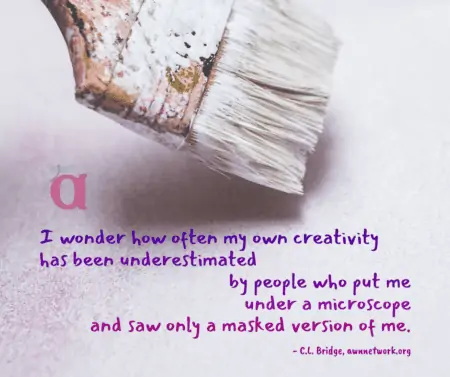
The Challenges of an Autistic Artist
Lately, nothing I create seems good enough. Maybe it’s because I’ve been stuck at home with my thoughts for several days, and sometimes my thoughts are not very kind to me. Maybe I need to try a different method or medium. Whatever the reason, I’ve decided to take a short rest from making art, and use this time to talk about the challenges of being an autistic artist.
As a university student, I struggled with vague instructions in my art classes. If an assignment’s goal was to follow my own lead and create something new, I needed the teacher to specifically say that. Otherwise, I would stiffen up, wondering just what their hidden expectations were and whether I fell short of those expectations. Homework assignments needed to be written on the board. If they were only announced out loud, I might misunderstand them or miss them entirely, especially if I were still working on my art when the homework was announced. Fortunately, my professors were understanding about writing things down once I told them about my needs.
Another difficulty was being expected to “look” as if I were concentrating. In studio classes, we each stood working at a drawing horse (a platform to put the drawing tablet on, not an actual horse) for several hours. I prefer to work in short bursts, pace for a while, then go back to drawing or painting. It may look flighty to observers, but I work better that way. Sitting for hours in graphic design class was torture for both my brain and my back. In a particular drawing class, the close quarters made concentration impossible for me. I was allowed to do my drawing in the office next door as an accommodation, but I still felt confined.
Both as a student and now, I have had to confront the myth that autistic people lack imagination and are poorly suited for the arts and humanities. I remember my utter disappointment when I searched the university’s database for papers on autistic creativity. All I found were papers on “impoverished creativity” in autism. Knowing how my brain freezes up under scrutiny, I wonder how often my own creativity has been underestimated by people who put me under a microscope and saw only a masked version of me. I also wonder how many autistic students who might have excelled in the arts and humanities have been steered away from these fields due to stereotypes. If you’re told over and over that people like you aren’t creative or capable of abstract thought, you might start to believe it.
Speaking of masking, it can interfere with my creative process even when I am working in privacy. I constantly ask myself, “Is this really me? Is this really what I want my art to be like, or am I only trying to be what an artist is ‘supposed’ to be?”
Autistic inertia (difficulty stopping or starting a task) can also get in the way of making art. Starting a piece is nearly always the hardest part. Even when I really want to do a project, my brain may get overwhelmed with all the steps involved and go “Nope!”… especially if the project involves a new skill or medium and I am afraid to get it wrong. It can be hard to take a break when I’ve overworked a piece and need to step away from it. I don’t want to leave it looking “wrong” overnight.
Connecting with others at gallery shows (mine or someone else’s), can be tough too, especially since I have social anxiety. People talk over each other, move around constantly, and get distracted easily. It can be almost impossible for someone who doesn’t quickly process words or conversational cues to get a word in. I have actually cried over how difficult it is for me to be heard at such events. Even when I do get someone’s attention, I struggle to put my ideas about art into the right words.
The arts can be a haven for autistic people—an environment where our traits and talents can be appreciated, and we can express ideas we may not be able to say in words. However, please be aware that other autistic artists may have challenges similar to the ones I’ve described. By talking about these difficulties, we can make the arts more welcoming and accessible to neurodivergent people.
